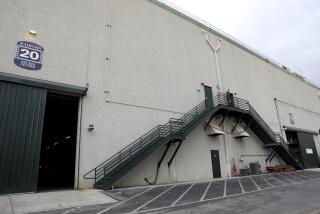Safety Procedures Faulted in Ride Injury at O.C. Fair
- Share via
State investigators have determined that a safety system failed on a ride at the Orange County Fair on Sunday and that a woman injured on it should not have been allowed to go through with the 70- to 80-foot free-fall.
Contrary to the initial account of a safety consultant employed by the fair, the woman, insufficiently supported by a two-net system, hit a pad on the ground when she took the plunge on the Adrenaline Drop, the state officials said.
For the record:
12:00 a.m. July 17, 2003 For The Record
Los Angeles Times Thursday July 17, 2003 Home Edition Main News Part A Page 2 National Desk 1 inches; 52 words Type of Material: Correction
Fair accident -- Articles in some editions of the California section Tuesday and Wednesday about an accident Sunday at the Orange County Fair incorrectly reported that the incident is being investigated by Cal/OSHA. The investigators are from the Elevator, Ride and Tramway Unit of the state Division of Occupational Safety and Health.
“The whole issue is the safety net wasn’t where it was supposed to be,” said Susan Gard, a spokeswoman for Cal/OSHA, or the state Division of Occupational Safety and Health. “There was some kind of break in the procedure, whether mechanical, operator error or a combination of both.”
Aidyl Sofia-Gonzalez, 30, was hurt when the net system stretched to the ground and she hit a 4- to 5-inch-thick pad, Gard said. If the net system had been set at the correct height, it would have stretched like a bungee cord, bounced several times with the weight of the rider and held her 10 to 15 feet above the ground, Gard said. The woman’s husband and two children watched as she made her plunge.
After spending the night at Western Medical Center-Santa Ana, Sofia-Gonzalez was at her La Canada Flintridge home Monday. Her family declined to provide details of the accident or her injuries.
The ride was stripped of its permit after the accident and will be closed until the state certifies it as safe. Investigators from Cal/OSHA are expected to file a report in two to five days, fair manager Becky Bailey-Findley said in a news conference at the fairgrounds in Costa Mesa. The ride could be closed permanently, she said.
Bailey-Findley said this was the first serious accident for a patron on a ride at the fair since 1993, when eight people were injured on a roller coaster.
The Adrenaline Drop is owned by Amusement Management International of Carrollton, Texas, and is one of the fair’s most popular rides. According to the company’s Web site, “It is the only system in the world that allows a participant to experience a controlled, unattached free-fall.”
The site says air tubes and suspension gear around the nets stop the rider’s fall gently, “resulting in a very intense free-fall experience.”
Alan Putter, owner of Amusement Management, declined to comment Monday. Gard said Putter might have been running the ride when the accident occurred.
Adrenaline Drop, which costs $35 per person, is the only AMI-operated ride at the fair. The company uses its own ride operators, Bailey-Findley said. The ride is manufactured by MONTIC, a German company.
Gard said Adrenaline Drop had a series of procedures to keep riders safe.
A rider is hoisted into the air in a basket while wearing a harness attached to the basket. When the rider reaches the top, the two safety nets automatically rise 30 to 40 feet. When the nets reach their position, a mechanism clicks into place so the rider can be released.
A buzzer notifies operators at the top and bottom that the nets are in place. The ground operator gives a hand signal and uses a radio to tell the operator who is up at the top with the rider that everything is ready.
The operator at the top asks the rider if he or she is ready to drop and releases the harness. Then the operator pushes a handle to open the bottom of the basket, allowing the rider to plunge.
Because the net system was not high enough to prevent Sofia-Gonzalez from hitting the ground, the second net made no difference, Gard said.
Gard’s description of what happened differs from that given Sunday by Barry Schaible, the fair’s ride safety consultant. He said Sofia-Gonzalez never hit the ground and that “everything did what it was supposed to do.”
Bailey-Findley confirmed Monday that the rider hit the foam mat on the ground.
Gard said officials from her division inspected the Adrenaline Drop on Friday and issued a permit after checking maintenance and training records and doing a run-through with weights instead of a rider. “It was in fine working condition Friday,” she said.
Bailey-Findley said riders on the Adrenaline Drop were offered a chance to have their plunge videotaped for $15. She said she did not know whether Sofia-Gonzalez’s fall was taped. AMI would have that tape, Bailey-Findley said.
Portable amusement park rides need a permit from the state to operate, and Cal/OSHA inspects them annually. Larger thrill rides, such as Adrenaline Drop, are checked two or three times a year, Gard said.
Documents on file with Cal/OSHA show that in September 2001 and June and July 2002, Total Thrill Rides Inc., a company affiliated with Amusement Management, was ordered to make minor repairs to Adrenaline Drop.
Gard said those orders were not uncommon. “If there was a safety hazard, we wouldn’t issue them a permit,” she said.
Records also show two other accidents on rides Putter owned that the division investigated. One was in 2001 at the California State Fair in Sacramento, and the other was at the Riverside County Fair and National Date Festival in February 2002, in Indio.
Gard said the records “did not exhibit or demonstrate a habitual pattern of negligence on the part of the operators.”
*
Times staff writers Mai Tran and Joy Woodson contributed to this report.
More to Read
Sign up for Essential California
The most important California stories and recommendations in your inbox every morning.
You may occasionally receive promotional content from the Los Angeles Times.











